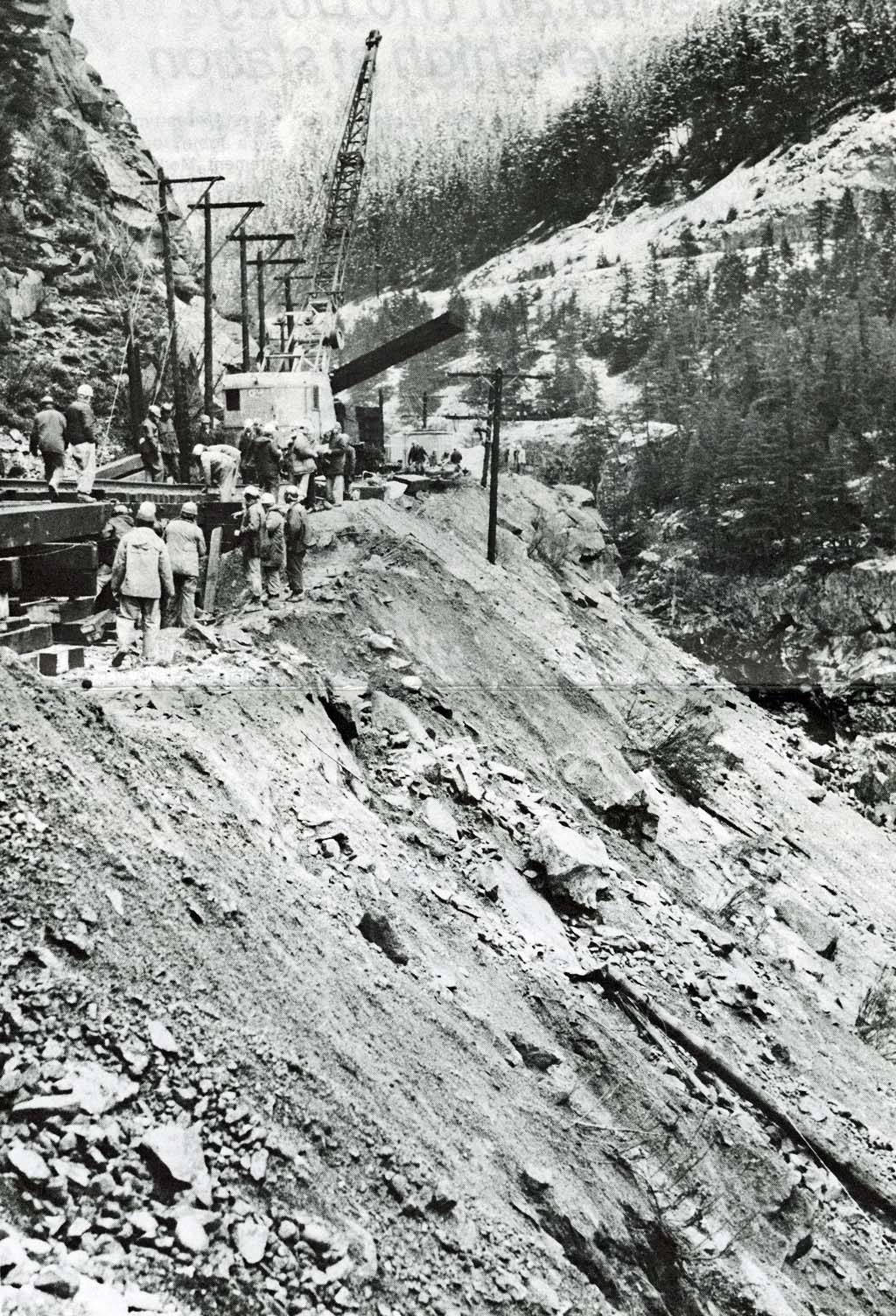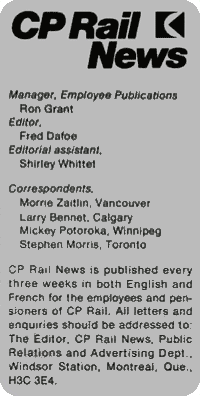
Number 7
May 28, 1980
for Floods, Washouts

Each year, CP Rail's track maintenance forces evaluate plans to meet the threat of floods and washouts from run-offs and rain.
Men, supplies, and heavy equipment are placed on call for movement to locations through the Fraser Canyon, along the Thompson River Valley, or Vancouver Island where they may be required.
Timber, rock, gravel, culvert piping, and bridge materials are stockpiled. Thousands of sandbags are gathered together for use in case of rising flood waters along the rail line.
INSPECTION TOURS
Roadmasters make "recon" patrols, track inspection tours of the line, and relay up-to-date situation reports to divisional headquarters. Culverts are checked constantly for debris, snow, and ice which could impede the flow of the spring thaw.
Washouts could occur if water isn't permitted to flow freely through the culverts. As the water builds up, pressure becomes too great, causing the ground to weaken and wash away.
 Mud and rock slides are often more destructive. Normally, a result of a combination of warm weather, freeze-thawing, and heavy rain, a slide may send
tons of rock and mud down a mountain side onto the track. CP Rail has installed slide detector fences at key locations along the rail line to warn
oncoming trains of a slide on the track. Miles of ditches are dug to protect sections of the line susceptible to slides.
Mud and rock slides are often more destructive. Normally, a result of a combination of warm weather, freeze-thawing, and heavy rain, a slide may send
tons of rock and mud down a mountain side onto the track. CP Rail has installed slide detector fences at key locations along the rail line to warn
oncoming trains of a slide on the track. Miles of ditches are dug to protect sections of the line susceptible to slides.
In 1974, the railway began developing its defence line between Kamloops and Hope through the Canyon, and along the Thompson River with a series of rock stabilization programs. Rock walls were scaled and in some areas, a concrete mixture was applied to the rock face to prevent further weathering.
To prevent slides, buried drainage pipes were installed. Heavy rock was packed around bridge supports and piles to break the water's force. The program has cost the railway an estimated $5 million since 1974.
Between 11 and 20 Dec 1979 last year, over 4.2 inches of rain fell in the Fraser Canyon, and almost 12.6 inches deluged the Port Alberni area on Vancouver Island.
Despite round-the-clock efforts by track forces, the heavy rains caused floods, washouts, and slides to close the mainline on four separate occasions during that period.
Just west of Lytton, 155 miles northeast of Vancouver, a slide sent more than 3,000 yards of rock plummeting onto the mainline, burying almost 150 feet of track. Four trailer flatcars and a caboose from a 60 car eastbound freight train were swept off the track down an embankment.
Four crewmen riding in the caboose were slightly injured. The derailed caboose, which somersaulted 120 feet down the steep embankment, stopped just short of plunging into the Fraser River.
On the Westminster subdivision, between Coquitlam and New Westminster, areas of track were under two feet of water as high tides and heavy rains brought on flooding.
OVERFLOWED
On Vancouver Island, the Koksilah River overflowed near Cowichan, washing out a section of track. Flooding was reported at other points along the line bringing traffic on the entire Esquimalt & Nanaimo Railway line to a standstill.
As winter rains retreated, CP Rail began to regroup its forces. Record rains had taken their toll. Over 250 men worked around the clock during the nine day stretch. More than $750,000 was spent to repair and replace retaining walls, culverts, track, and other damage.
 and is reprinted here with their permission.
All photographs, logos, and trademarks are the property of the Canadian Pacific Railway Company.
and is reprinted here with their permission.
All photographs, logos, and trademarks are the property of the Canadian Pacific Railway Company.